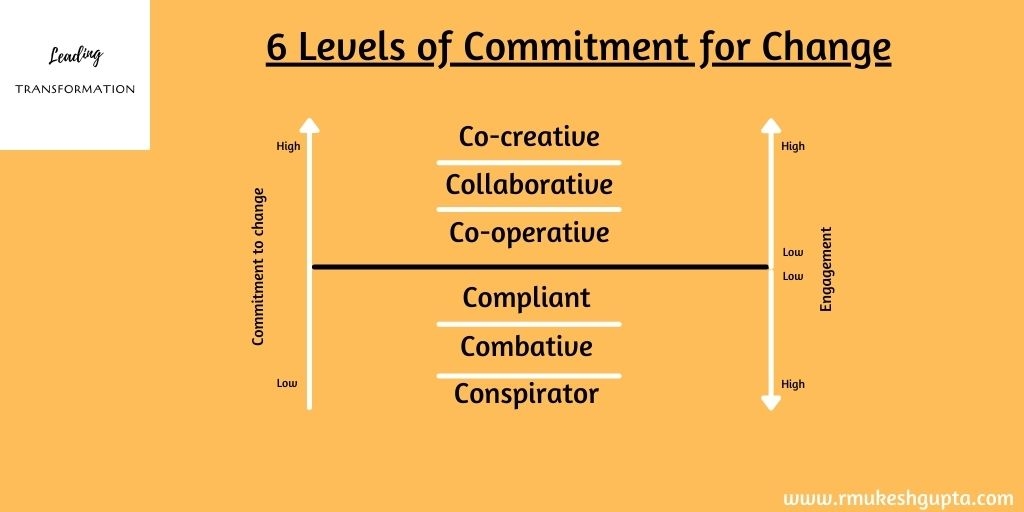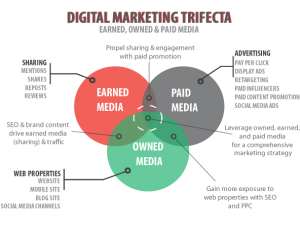
Premise:
Every change or a transformation effort needs the support and commitment of people who will either be affected by the change or who lead the change or who could influence the success of the change effort. Hence, it is important for those who want to drive or lead the change effort learn how committed they are to the change.
The commitment can vary from people wanting to outright sabotage the change on one extreme to co-creating or co-owning the change on the other end of the spectrum. Along the spectrum, there are 6 levels or stages of commitment that people could exhibit in the spectrum.
As leaders who are driving the change, it is our responsibility to learn and understand where on the spectrum do each one of our key stakeholders are. Once we know this, we can then plan activities or communications to bring them to the appropriate level of commitment that we want them to be at.
Here are the 6 levels of commitment and what that means for us, as leaders of the change effort.
Conspirator:
These are people who are highly engaged with the change effort but with the lowest commitment to the change. They actively look at ways and means to sabotage the change efforts. Usually, they work behind the scenes and are always trying to garner support for their point-of-view, which, in most cases, is to stay in stasis. They prefer status quo over anything kind of change.
Combative:
These are people who are engaged with the change effort but with low commitment to see the change through. They actively resist the change. They are open about it. Usually, they are the traditionalists, who prefer to follow traditions. They are also the people who are most likely to use terms like “Why try to fix something that is not broken?”. It is easy to identify them because they are open about their dislike for the change.
Compliant
These are people who have low engagement to the change process and medium commitment to change. They will comply with what is expected of them, as long as they see everyone else complying to the change as well. They will do what everyone else does – nothing less and nothing more. Their engagement with work is among the lowest amongst all the other people at all the different levels of commitment. Usually, most of the people who are affected by the change effort would be at this level of commitment. Usually, they will not get in the way!
Co-operative
These are also people who exhibit low to medium engagement with their work in general and to the change efforts. However, they are a bit more committed to the change efforts. They are more than happy to provide resources that they own or control for the change efforts. They personally participate and support the change, but as individuals. They see that they either have something to gain from the stasis resulting from the change effort. Usually, these are people in the middle management, who aspire to grow within their organisation and hope that by co-operating, they can create the opportunity for them to grow.
Collaborative
These are people who exhibit high level of engagement with the work and the change effort. They are also committed to the change and the vision that is driving the change. They are willing to stick their neck out and openly support the change effort. They are also willing to work as change agents, who are willing to work with us to drive the change. They can potentially be multipliers for us within the organisation to drive the change and can also serve as the eyes and ears for us to listen to the mood within the organisation.
Co-creative
These are people who are gung-ho about the change that we are trying to drive with the organisation. They are highly engaged with their work and highly committed to the change. Usually, they are more than willing to sit down with us to co-create the change. They are also willing to take high personal risk to defend and promote the change. Usually, these are people who understands the need for the change at an emotional level and find that the change is not only necessary but is imminent. They are great candidates for being change agents within the organisation.
In Conclusion:
In conclusion, it is important to realise that, in any change effort, we will have people exhibiting commitments at each of these levels. It is important to take this into account and plan accordingly. This needs to be done as part of the stakeholder management. We need to be aware of the levels that people are at and where we need them to be in order for the change effort to succeed and based on this, find ways to move them to that level of commitment (through communication, influence – direct or indirect, persuasion) to ensure the success of the change efforts.
Business & Finance Articles on Business 2 Community
(79)
Report Post






